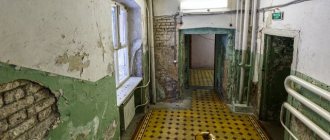When they talk about emergency and dilapidated residential real estate, then at the everyday level it is implied that the housing is unsuitable for a comfortable life. But it should be understood that there is a significant difference between such concepts. Dilapidated housing differs from a dilapidated building in that the buildings have a lot of wear and tear, their living conditions are deteriorating, but safety for residents is maintained.
Features of dilapidated residential buildings
To understand which houses are classified as dilapidated, you need to refer to the methodological manual MKD 2-04.2004, which describes the requirements for housing maintenance. The document states that the wear and tear of a dilapidated home is:
- For stone buildings - more than 70%.
- For wooden houses - more than 65%.
The concept of “dilapidated residential premises” is not used in current legislation. That is why citizens living in houses with a lot of wear and tear have problems due to the fact that housing that does not meet operational requirements, but maintains the safety of living, is not subject to demolition. For this reason, it is not included in current regional resettlement programs.
That is, the difference between a residential dilapidated building and a dilapidated house is that, while living comfort conditions decrease, the main elements that influence the stability of the building remain in satisfactory condition.
For people living in dilapidated houses, the main problems are related to the fact that major repairs and reconstruction in buildings with more than 70% wear and tear are not provided for from budget funds. Government authorities admit that people live in inappropriate conditions, but there is no threat to their lives. This is not enough to provide other types of housing. The owner of premises in a dilapidated house cannot expect relocation.
Actual problems
The crisis in the construction industry has had a negative impact on the resettlement of citizens from dilapidated buildings. In addition, the number of such buildings is increasing dramatically.
Providing economical housing to citizens who are part of the vulnerable segment of the population (the majority of those living in unsuitable conditions belong to this category) is possible only with large government injections .
The main difficulty that arises in the process of solving the resettlement problem is the common opinion of officials regarding the amount of area provided in return . Some are guided by Art. 50 of the Housing Code of the Russian Federation, which states that each family member must live in a standard number of square meters, and others - Art. 89 of the Housing Code of the Russian Federation, which determines that the family must receive in return premises that are not inferior in size to the one occupied previously. Such disputes are possible only if we are talking about social rental housing, since the owner of a dilapidated apartment can only receive a similar number of square meters instead.
Actions to qualify for resettlement
Understanding the difference between dilapidated and emergency housing, you can take measures to recognize the building as emergency.
If the conditions for safe living are not met, residents must write a statement declaring the house unsafe and send it to the district administration.
Additionally, the following documents must be submitted:
- Complaints about the unsuitability of housing from the owners of any apartments.
- Technical data sheets and layouts of residential premises.
- Documents certifying the right to residential premises from each owner, certified by a notary.
The procedure itself is regulated by a special government decree. Recognition for resettlement or demolition is carried out by a special interdepartmental commission. It is created no later than a month after the application is received by the civil service. It may include a representative from the people living in the building, which is in a dilapidated condition, but he will only have an advisory vote. If the commission made a decision that is unsatisfactory to the residents, an independent construction and technical examination must be ordered. It will allow you to challenge in court the decision of the interdepartmental commission on the demolition of emergency and dilapidated housing.
The commission will consider the following main criteria:
- The condition of load-bearing and enclosing structures, namely the presence of all kinds of destruction and damage in them;
- Slopes and strength of staircases;
- Condition of engineering systems and compliance of conditions with sanitary and epidemiological requirements;
- The condition of the external walls, in terms of providing them with adequate thermal insulation;
- Protection of housing from the penetration of external negative natural influences;
- Availability of an elevator in buildings with a height of more than 5 floors.
Building condition assessment
To assess the unsafe condition of a home, it is necessary to send an application to the local administration , outlining the current condition of the property. It is this paper that will serve as the basis for the meeting of an interdepartmental city commission.
must be attached to the application :
- certificates of title to this property, certified by a notary;
- floor plan;
- technical passport.
The applicant can be not only the owner of the property, but also the institution responsible for government supervision and control.
An expert who is part of the commission can assess the actual condition When conducting an examination, it is necessary to calculate not only the degree of wear, but also indicators of noise, vibration, illumination, humidity, electromagnetic background, etc.
Based on the results provided, local authorities will be able to decide what exactly needs to be done: demolish or reconstruct the building.
To determine the degree of dilapidation of a home, a commission is also assembled, which includes: employees of the housing and communal services sector, BTI workers, designers, etc.
Features of emergency houses
In order for a residential building to be recognized as unsafe, it is necessary to confirm the danger to residents by the following indicators:
- Deformation or damage to any structural element of the building (load-bearing wall, balcony, ceiling), which leads to a decrease in the strength and reliability of the structure.
- Destruction of the foundation of a house or supporting structures due to long-term use.
- Biological damage to wooden structures that impairs the load-bearing capacity of the structure.
- The presence of damage that cannot be repaired by modern construction methods, caused by natural disasters or soil subsidence.
- The presence of serious damage caused by any man-made accident or fire, which led to the fact that restoration work is impossible or economically unjustified.
- The house is located in a dangerous area, with an increased likelihood of avalanches or flooding.
A decision on whether a house is unsafe is made within a month. The interdepartmental commission issues a conclusion, which may contain the following information:
- On the compliance of housing with operational requirements.
- About the need for major repairs or work aimed at redevelopment.
- About the impossibility of living in the building.
Recognition procedure
Any structure wears out over the years, and then even becomes unsuitable for further habitation.
In 2006, Government Resolution No. 47 , according to which houses in disrepair are now being demolished.
In order for a home to be recognized as dilapidated, the following actions :
- report in writing about the deplorable condition of the house to the relevant commission (send an application);
- if a negative result is returned from the previous authority, then you should visit the institution that evaluates the housing for unsuitability and obtain a technical opinion;
- send a statement of claim to the court, attaching a previous document to it as confirmation of your words;
- obtain a forensic construction report from the technical laboratory that determines the condition of the house.
Typically, severely worn-out buildings, as well as those damaged by an accident, fire or explosion, are demolished.
The following indicators also indicate the unsuitability of housing: humidity more than 60% and temperature below 18 degrees in the cold season, as well as ceiling heights less than 2.5 meters. No one will demolish such buildings, but it will be possible to obtain an obligation to carry out major repairs.
When relocating owners of dilapidated or dilapidated apartments, the following area standards are taken into account - at least 33 square meters per person. m., and for each family member - 18 sq. m.
Residents' rights
The Fund for Assistance to the Reform of Housing and Communal Services, created to provide comfortable and safe living conditions for citizens of the housing sector, provides mechanisms for the resettlement of residents of dilapidated buildings. The program is implemented by the highest regional executive body, and the necessary funds are allocated to local budgets in accordance with the law.
It is very important to know what problems residents can expect when moving out. According to current legislation, during resettlement, residents must be provided with appropriate housing in terms of amenities and square footage. Citizens applying for an increase in space are provided with an apartment taking into account the missing meters.
The provided property must have a kitchen stove and plumbing fixtures installed. Also a prerequisite is connection to all necessary engineering systems and communications:
- heating,
- Sewerage,
- Water supply,
- Electricity supply.
You should know that when moving into an emergency home:
- Residents are offered three options, but their individual wishes are not taken into account. Relocation to communal apartments is not carried out.
- New residential premises are provided in the area where the emergency building is located. Moving to another area is possible only with the consent of the residents.
- Owners of emergency apartments cannot enter into exchange agreements. It is also impossible to sell the apartment. Any such transaction is illegal.
- Local authorities allocate moving costs, but the necessary transport is allocated only once.
- If a citizen does not have a document certifying ownership, and he lives under a municipal rental agreement, then new housing is provided to him on the same terms.
All issues related to resettlement must be agreed in writing with the residents by government authorities. If any of the owners decides to receive compensation, then the redemption value of the housing recognized as unsafe is calculated.
Payment of compensation
After a house is declared unsafe, local authorities must decide whether to provide the families living in it with other living space or financial compensation , the amount of which is determined by municipal specialists.
Market value is used to evaluate the property, and the transfer of money is carried out in accordance with the repurchase agreement. An owner who does not agree with the results can send a written notice to the administration with a request to carry out a review or file a statement of claim and submit everything to the court.
The rules for providing monetary compensation or other residential real estate in replacement of damaged property are described in the following video:
What is necessary for a property to be declared uninhabitable?
In order for a property to be assigned the status of unfit for human habitation, the following actions must be performed:
- write a class action lawsuit from the residents of the building to the administration;
- based on the application, a commission should be formed to inspect the house;
- experts must draw an opinion on the condition of the property;
- making a decision within 5 days;
- If a house is deemed unfit for human habitation, they will be resettled.
Resettlement should occur within 2 weeks, but this may take longer.








